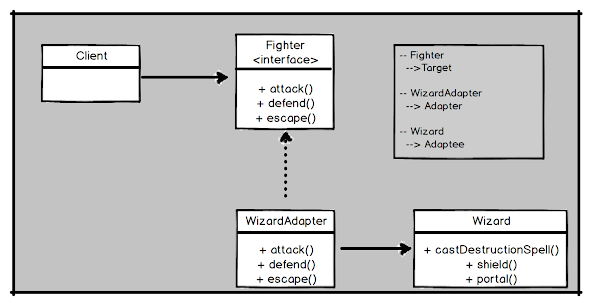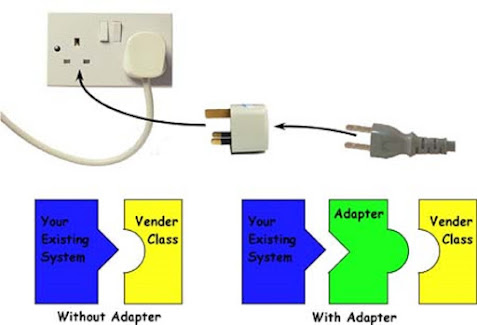How to use the Adapter design pattern in Java
The Adapter design pattern in Java , also known as the Wrapper pattern, is another very useful GOF pattern that helps bridge the gap between two classes in Java. According to the Gang of Four pattern list, Adapter is a structural pattern, much like the Proxy, Flyweight, Facade, and Decorator patterns in Java . As the name suggests, Adapter allows two classes with different interfaces to work together without changing any code on either side. We can think of the Adapter pattern as the central piece of a puzzle, which connects two pieces that cannot be connected directly because of different interfaces.
How to implement the Adapter design pattern in Java?
There are two ways to implement the adapter design pattern in Java, one using inheritance, also known as the class adapter pattern, and the other using composition, also known as the object adapter pattern. In both cases, it is best to declare the public methods that interact with the client in an interface, which we can call the target interface.
One advantage of wrapping client-facing methods in adapters using target interfaces is that we can create a loosely coupled design and we can replace the adapter with a better implementation at a later stage of development.
Now your Class Adapter pattern extends the original interface, which is not compatible with the client but provides the functionality required by the client, and it also implements the target interface. Now, the way the Adapter implements the target method is by delegating the actual work to the original class, which the Adapter accesses by extending it.
Similarly, in case of Object Adapter pattern, which uses composition to reuse code, it also implements the target interface and uses the object of the original incompatible class to do all its work. Preferring composition over inheritance, I would suggest that you should stick with Object Adapter pattern.
Here is a UML diagram of the Adapter design pattern, which should make things easier to understand and clear up any doubts we had about the structure of the pattern:

In this example, Client is a target interface and Wizard is Adaptee. To facilitate the use of Wizard, we created WizardAdapter, which implements the target interface Fighter, but delegates the work to Adaptee.
Adapter Pattern in Java - Map Adapter
Let's look at another example of the Java Adapter pattern. If you remember, java.util.Mapthere is no way to automatically load a two-dimensional array of objects into a Map as key-value pairs. We can create an adapter class to do this.
Sometimes the problem you are trying to solve is as simple as "I don't have the interface I want." Two patterns from the GOF design patterns list, Adapter and Facade, solve this problem by providing an alternate interface.
The Adapter pattern takes any interface we have and generates the interface we need. Whereas the Facade pattern provides a simpler interface to handle multiple classes or resource bundles.
This is my implementation of the Adapter pattern in Java, which is used to convert a two-dimensional array of objects into a Map of key-value pairs.
Java Program to Implement Adapter Design Pattern
import java.util.AbstractMap;
import java.util.HashMap;
import java.util.Map;
import java.util.Set;
public class Test {
public static void main(String args[]) {
Integer[][] squares = {{2, 4}, {3, 9}, {4, 16}};
MapAdapter adapter = new MapAdapter(squares);
System.out.println("adapter map contains : " + adapter);
}
}
class MapAdapter extends AbstractMap {
private Map map;
public MapAdapter(Object[][] array) {
super();
map = new HashMap();
for (Object[] mapping : array) {
map.put(mapping[0], mapping[1]);
}
}
@Override
public Set entrySet() {
return map.entrySet();
}
}
We can see that our MapAdapterextends AbstractMap to create a Map that can take a two-dimensional array and create a HashMap from it.
This is a more interesting diagram that will help you understand the intent and purpose of the Adapter pattern in Java. We can see that the existing system and supplier classes did not fit together initially, but when we added the adapter, the puzzle was solved and both systems could be plugged together.

Key points about Java Adapter pattern
Now, let's look at some key points about Adapter pattern in Java. These key points will only provide you with why and when to use the Adapter design pattern and other advantages and disadvantages of Adapter pattern in Java software development.
- Adapter design pattern ensures code reusability by delegating the client calls to the original class, i.e. it acts as a wrapper for the original interface, that is why it is also known as wrapper pattern or simply wrapper. This is actually the main benefit of using the Adapter pattern.
- The Adapter pattern is a common pattern, much like Singleton, Factory, and Decorator, you will see many examples of the Adapter pattern through the code, and one of the main benefits of using the Adapter pattern in Java is code reuse, making incompatible interfaces work together and loosely coupled, because Adapter tends to encapsulate incompatible interfaces well.
- One of the situations where the Adapter design pattern is used in a Java program is when using a third-party library. By ensuring that our program uses an adapter that we control, rather than using third-party interfaces and classes directly, you can always replace the third-party library with a similar, better performing API. We can count this as one of the advantages of using the Adapter pattern.
- In the Gang of Four design patterns, the Adapter pattern belongs to the Structural design pattern along with the Proxy, Facade, and Decorator design patterns.
- Many programmers confuse the Adapter and Decorator design patterns in Java, they are similar to some extent, especially the object-based adapter pattern, but there is a subtle difference between the Decorator and Adapter pattern in Java. Adapter simply converts one interface to another without adding extra functionality, whereas the Decorator pattern adds new functionality to the interface. Refer to the article about Difference between Adapter and Decorator pattern in Java to learn more.
- We can also use the Adapter design pattern in Java to convert classes, for example suppose our client does all calculations in Miles and the library we are using requires Kilometers. In this case, we can write an Adapter class which gets the Miles from the client, converts it to Kilometer and makes use of the external library methods to do all the calculations. While returning the result, it can convert KM back to Miles and send the result to the client.
- Prefer object-based adapter design pattern over class-based because the former uses composition to reuse code and is more flexible than the inheritance-based approach of class-based adapter pattern in Java.
That's all about what is Adapter design pattern in Java, how and when to use Adapter pattern, and the difference between class-based and object-based implementation of Adapter design pattern. Adapter is a very useful and common pattern that Java developers should leverage as much as possible to write flexible code.
For reprinting, please send an email to 1244347461@qq.com for approval. After obtaining the author's consent, kindly include the source as a link.
Related Articles
Store Div Id in PHP variable and pass it to JavaScript
Publish Date:2025/04/13 Views:51 Category:PHP
-
This article shows you how to div id store a in a PHP variable and pass it to JavaScript code. We will answer the following questions. What is div id ? How to div id store in a PHP variable? How to pass variables to JavaScript code? Let’s
Use of Linux command at - set time to execute command only once
Publish Date:2025/04/08 Views:158 Category:OPERATING SYSTEM
-
This article mainly involves a knowledge point, which is the atd service. Similar to this service is the crond service. The functions of these two services can be similar to the two functional functions of javascript. Those who have learned
Design Patterns in Java - Visitor Pattern
Publish Date:2025/03/19 Views:175 Category:ALGORITHM
-
Today, we are going to learn one of the most useful patterns, the Visitor Pattern. What is the Visitor pattern? Well, let's look at an example. Let's say you're a software engineer working at a university. The university rarely has establis
How to use Strategy Pattern in Java?
Publish Date:2025/03/19 Views:142 Category:ALGORITHM
-
Hi everyone, you might have heard, “Can you tell me about any design pattern other than Singleton design pattern that you have used recently in your project?”. This is one of the popular questions in various Java interviews in recent ye
Difference between Proxy Mode and State Mode in Java
Publish Date:2025/03/19 Views:76 Category:ALGORITHM
-
Hi guys, if you are preparing for Java interview and looking for difference between Proxy and State design pattern, then you are at the right place. In the past, I have explained several important object-oriented design patterns like State,
Strategy Design Pattern and Open-Closed Principle in Java
Publish Date:2025/03/19 Views:114 Category:ALGORITHM
-
The Strategy design pattern is based on the Open/Closed design principle , the famous " O SOLID " of design principles . It is one of the patterns that has become popular in the field of object-oriented analysis and design, along with the D
How to implement binary search in Java without recursion?
Publish Date:2025/03/19 Views:198 Category:ALGORITHM
-
Hey Java programmers, if you want to implement binary search in Java and looking for iterative and recursive binary search algorithms, then you have come to the right place. Today I am going to teach you an important algorithm. In computer
How to implement the singleton pattern in JavaScript ES6+
Publish Date:2025/03/19 Views:55 Category:ALGORITHM
-
In this article, we will show you how to implement the singleton pattern in JavaScript. If we are a full-stack JavaScript developer, we know that JavaScript is a powerful language and we can build amazing websites with it. On the other hand
Java Decorator Design Pattern Example
Publish Date:2025/03/19 Views:116 Category:ALGORITHM
-
Hello everyone, if you want to learn about Decorator Design Pattern in Java , then you have come to the right place. As design patterns are very important while building software and equally important in any core Java interview, it is alway

